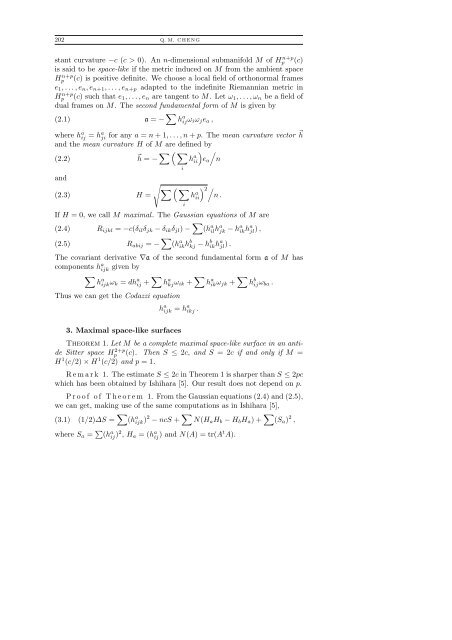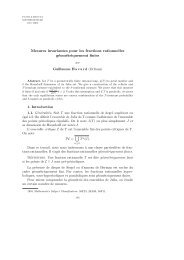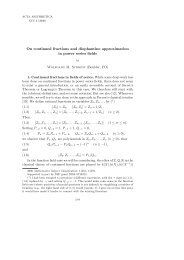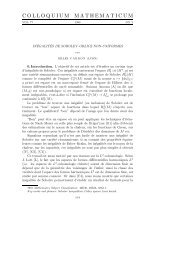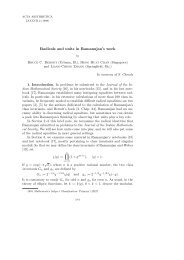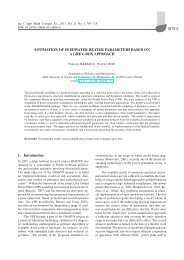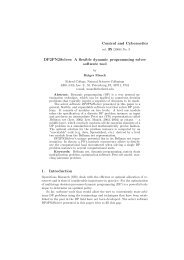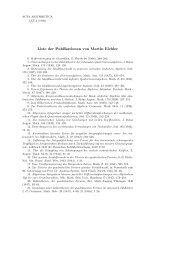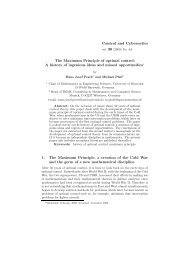SPACE-LIKE SURFACES IN AN ANTI-DE SITTER SPACE
SPACE-LIKE SURFACES IN AN ANTI-DE SITTER SPACE
SPACE-LIKE SURFACES IN AN ANTI-DE SITTER SPACE
You also want an ePaper? Increase the reach of your titles
YUMPU automatically turns print PDFs into web optimized ePapers that Google loves.
202 Q. M. C H E N G<br />
stant curvature −c (c > 0). An n-dimensional submanifold M of Hn+p p (c)<br />
is said to be space-like if the metric induced on M from the ambient space<br />
Hn+p p (c) is positive definite. We choose a local field of orthonormal frames<br />
e1, . . . , en, en+1, . . . , en+p adapted to the indefinite Riemannian metric in<br />
Hn+p p (c) such that e1, . . . , en are tangent to M. Let ω1, . . . , ωn be a field of<br />
dual frames on M. The second fundamental form of M is given by<br />
(2.1) a = − h a ijωiωjea ,<br />
where h a ij = ha ji for any a = n + 1, . . . , n + p. The mean curvature vector h<br />
and the mean curvature H of M are defined by<br />
<br />
(2.2)<br />
h = − n<br />
and<br />
(2.3) H =<br />
i<br />
<br />
i<br />
h a ii<br />
h a ii<br />
ea<br />
2<br />
n .<br />
If H = 0, we call M maximal. The Gaussian equations of M are<br />
(2.4) Rijkl = −c(δilδjk − δikδjl) − (h a ilh a jk − h a ikh a jl) ,<br />
(2.5) Rabij = − (h a ikh b kj − h b ikh a jl) .<br />
The covariant derivative ∇a of the second fundamental form a of M has<br />
components ha ijk given by<br />
<br />
a<br />
hijkωk = dh a ij + h a kjωik + h a ikωjk + h b ijωba .<br />
Thus we can get the Codazzi equation<br />
h a ijk = h a ikj .<br />
3. Maximal space-like surfaces<br />
Theorem 1. Let M be a complete maximal space-like surface in an antide<br />
Sitter space H2+p p (c). Then S ≤ 2c, and S = 2c if and only if M =<br />
H1 (c/2) × H1 (c/2) and p = 1.<br />
R e m a r k 1. The estimate S ≤ 2c in Theorem 1 is sharper than S ≤ 2pc<br />
which has been obtained by Ishihara [5]. Our result does not depend on p.<br />
P r o o f o f T h e o r e m 1. From the Gaussian equations (2.4) and (2.5),<br />
we can get, making use of the same computations as in Ishihara [5],<br />
(3.1) (1/2)∆S = (h a ijk) 2 − ncS + N(HaHb − HbHa) + (Sa) 2 ,<br />
where Sa = (h a ij )2 , Ha = (h a ij ) and N(A) = tr(At A).


